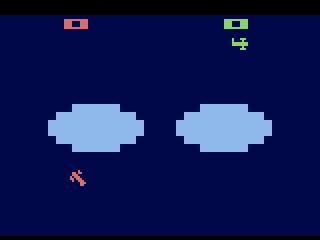Retro Replay Review
Gameplay
Combat delivers an intense head-to-head experience built around two simple goals: shoot your opponent’s vehicle and avoid getting hit yourself. Across its 27 distinct levels, the game cycles through tank duels, ricocheting “tank-pong” arenas, invisible tank challenges, speedy biplane dogfights, and supersonic jet battles. Each level adjusts the rules of engagement—guided vs. straight missiles, the presence of walls or clouds, even the number of aircraft per player—ensuring no two matches ever feel quite the same.
(HEY YOU!! We hope you enjoy! We try not to run ads. So basically, this is a very expensive hobby running this site. Please consider joining us for updates, forums, and more. Network w/ us to make some cash or friends while retro gaming, and you can win some free retro games for posting. Okay, carry on 👍)
On the tank levels (1–14), you’ll navigate mazes or open fields, sometimes guiding your missile with a joystick or watching it bounce off walls in classic “pong” style before scoring a hit. The invisible levels add a thrilling twist: your tank only materializes when firing or taking damage, forcing you to rely on intuition and sound cues. Moving on to biplane and jet fighter stages (15–27), you and your opponent take to the skies where constant forward motion, wrap-around screen edges, and alternating weapon modes (from rapid-fire machine guns to guided missiles) keep adrenaline high.
Difficulty settings on the Atari 2600 let you tweak missile range and aircraft speed, tailoring the challenge to veterans or newcomers. Every skirmish is capped at a brisk 136-second timer, resulting in tight, fast-paced rounds that are easy to pick up but hard to master. The depth of variation—double-plane teams, asymmetrical “1 vs. 3” showdowns, billiard-style hit rules—makes Combat a perennial favorite for quick competitive bursts.
Graphics
Graphically, Combat embraces the Atari 2600’s trademark simplicity. Vehicles are rendered as bold, blocky sprites with just enough detail to distinguish tanks, biplanes, and jets. Walls, clouds, and barriers use clean, contrasting colors, making it immediately clear where you can hide or risk a collision. While primitive by modern standards, these visuals deliver everything you need to keep track of two fast-moving opponents on the same screen.
The limited palette and coarse pixel grid give the game a nostalgic, arcade-style charm. Explosions flash brightly, and projectiles leave visible trails, helping players anticipate shots even in the most chaotic exchanges. In the invisible levels, the fleeting blips of a shooting tank or glint of a guided missile become critical visual cues, demonstrating how Combat cleverly leverages graphical constraints to heighten tension.
Overall, the visuals never distract from the action. There’s no background scenery or elaborate effects—just straightforward, responsive animation. This minimalist approach allows the game to run smoothly on vintage hardware and keeps the focus squarely on split-second aiming and strategic positioning.
Story
Combat doesn’t offer a narrative campaign or character backstories—instead, it presents a pure competitive sandbox where two players face off in vehicular warfare. The premise is as timeless as it is simple: you and an opponent control identical tanks or planes, and the first to outmaneuver and outshoot the other wins the round. This stripped-down concept serves as the entire “story,” emphasizing skill over plot.
What little context it provides is purely mechanical: different level types introduce new rules, such as guided missiles or invisible foes, but there’s no lore to explore or villains to vanquish. This lack of storyline might disappoint those seeking a traditional single-player journey, yet it perfectly aligns with Combat’s arcade roots, where the story is written in the heat of each match.
For players who relish crafting their own legends—epic comebacks, last-second victories, or crushing defeats—Combat’s blank narrative slate offers fertile ground. Every session becomes a personal tale of tactical brilliance or humorous blunders, shared alongside a friend or family member vying for bragging rights.
Overall Experience
Combat stands as a timeless testament to competitive game design. Its expertly varied level roster and easy-to-learn controls deliver immediate fun, while the myriad rule tweaks—from missile behavior to team configurations—ensure matches never grow stale. Whether you’re navigating tight tank mazes or dogfighting at jet speeds, every round lasts just long enough to stay thrilling yet leaves you craving “one more go.”
The game truly shines in local multiplayer, transforming any living room into an arena of frantic exchanges and laughter. The lack of single-player AI might limit solo practice, but it also underscores Combat’s purpose: to be best enjoyed as a shared experience. Few titles from the Atari era match its pure, undiluted competitive spirit.
In the pantheon of early console classics, Combat remains a shining example of how simple mechanics and clever level design can combine to deliver endless replay value. For anyone looking to explore gaming history or rekindle the adrenaline of vintage multiplayer battles, Combat delivers an experience that is as engaging today as it was over four decades ago.
 Retro Replay Retro Replay gaming reviews, news, emulation, geek stuff and more!
Retro Replay Retro Replay gaming reviews, news, emulation, geek stuff and more!









Reviews
There are no reviews yet.